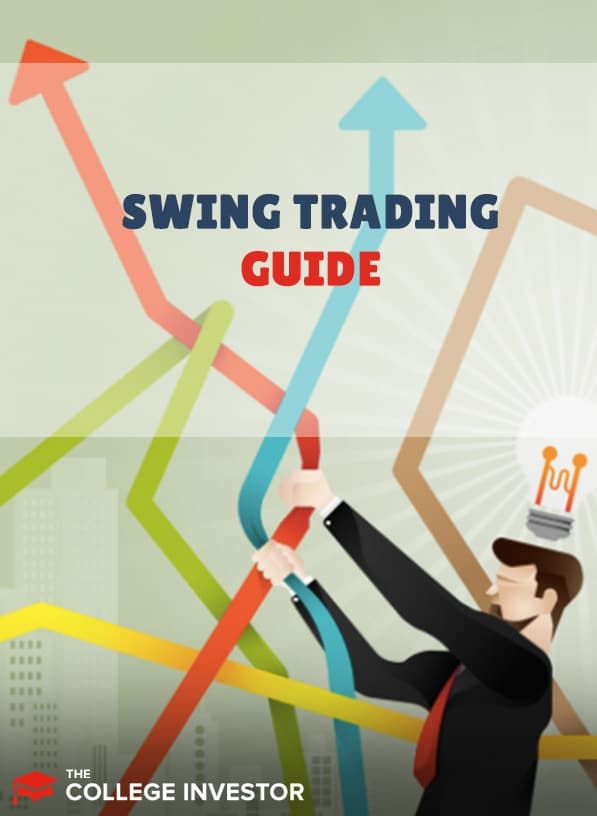
Swing trading is a style of trading stocks that isn’t day trading or investing. It sits in between those two styles. Day trading is going in and out of positions during a single day. Investing is holding for the long-term (i.e., months and years).
Swing trading positions are generally held for a few days or weeks. The specific types of trading strategies or techniques can vary widely—some associate swing trading with taking advantage of price swings while others prefer straight momentum up trends.
But, at its core, swing trading is more about the time a trade is held than any particular trading style. Let's take a closer look at how swing trading works to help you decide if it its a worthwhile strategy for making money in the stock market.
Swing Trading Vs. Day Trading
There are a few key differences between swing trading and day trading. First, swing trading is much less demanding of your time. Achieving success with day trading typically requires traders to commit several hours per day, while swing traders may be able to manage their trades in just a few hours per week.
Day trading, on the other hand, offers higher return potential over time. This is due to the simple fact that day traders are entering and exiting positions at a much faster pace.
To give an example, imagine that a day trader enters every position with a profit aim of 1.5% and sets a stop-loss of 1%. If the day trader makes eight trades per day and wins half of them, they'll earn a daily return of 2%. That would equate to a monthly return of about 40%.
Now let's assume that a swing trader sets a higher profit aim of 3% (with the same stop-loss of 1%) and also wins 50% of their trades. If the swing trader exits eight positions per month, they'll earn a monthly profit of 8%. That's certainly not shabby. But, in order to make 40% per month, the swing trader would need to significantly increase trade volume or set much higher per-trade profit aims.
Finally, it should be noted that swing traders deal with the risk of a stock suffering a steep drop overnight while the market is closed. Day traders don't have to worry about this as all positions are opened and closed "intraday."
Related: Could a Monkey Beat Your Portfolio If You're Day Trading
Identifying Opportunities
There isn’t anything specific to swing trading that helps traders identify opportunities. Traders may even apply their existing methods for identifying swing trades.
Some traders will use purely technical analysis, while others focus on fundamental analysis. There’s nothing wrong with using both, however, as they tend to complement each other.
For example, after researching a stock through fundamental analysis, nothing says you can’t supplement that research by identifying charting opportunities. Analyzing charts fall into technical analysis, which utilizes support and resistance areas, moving averages, volume, and more.
While fundamental research can tell you that a company is financially strong and has great prospects, technical analysis can tell you where some of the best trade entries are based on the stock’s price.
Choosing A Financial Instrument
Whether you trade futures, options, stocks, or ETFs, all are suited to swing trading. With futures and options, you might have to roll positions to the next contract if your holding period spans expiration. But that doesn’t exclude those instruments in any way from being used for swing trading.
If you are coming from day trading, there is a big difference to recognize with swing trading. Because swing trades are held overnight, margin requirements will increase, especially for futures. You’ll need to find out the overnight margin requirement and make sure you have enough cash in your account to cover it.
Long Or Short
Stocks can be bought long or short. Shorting a stock means opening a new position in the stock by selling it. This is a bet that the stock price will go down. Once the stock price reaches a specific level, you can buy it back to close the position.
There will need to be shares available at your broker for borrowing since shorting requires borrowing shares. Futures work a little differently when shorted. There are no contracts to borrow when going short futures. In a way, futures are easier to short than stocks.
Shorting is a very risky trading method. If you short a stock at $100 and it keeps going up, your loss will keep growing. The bad part is that a stock can continue rising, creating an unlimited loss.
Of course, the short can always be bought back to close it out. But the concept of a short having unlimited losses is certainly real. That isn’t the case when "going long." Since a stock's value can't drop beyond zero, the maximum you can lose is the total amount invested in the long stock. But you can lose far more when shorting a stock.
Risk Management
It’s important to recognize that swing trading isn’t investing. Positions are held for the short-term. Since the number of positions (and shares) that can be opened are dependent on a trader’s account size, positions will need to be periodically closed so that the trader can take advantage of new opportunities.
Trades also don’t have as much time to recover from a loss. Before a trade starts going against you, figure out how much you’re willing to lose so that you have a game plan going in. Remember, with swing trading; there’s only so much time to give to give a trade, whether it's winning or losing.
When a trade is going in your favor, it can be tempting to "let it ride." This means just keeping the position open and watching the profit continue to climb each day. Of course, if it were that easy, everyone would do it.
But the market has a way of messing up your plans when you stay in a trade too long. The better route is to begin scaling out of the position. This means taking off contracts in stages. That way, you are capturing some of your profits or reducing losses.
Final Thoughts
Swing trading doesn’t have to be exclusive to any other trading styles. If you are an investor, you can continue investing. If you are a day trader, you can continue day trading.
For investors, as the market gets more volatile, they may find better opportunities through swing trading. For day traders, who are constantly on the lookout for trades, they may periodically identify trades that are more ideal for multi-day trading.
The styles, techniques, and strategies available to traders and investors are enormous. Swing trading is just another tool to put into your trader/investor tool bag and utilize as needed.

Robert Farrington is America’s Millennial Money Expert® and America’s Student Loan Debt Expert™, and the founder of The College Investor, a personal finance site dedicated to helping millennials escape student loan debt to start investing and building wealth for the future. You can learn more about him on the About Page or on his personal site RobertFarrington.com.
He regularly writes about investing, student loan debt, and general personal finance topics geared toward anyone wanting to earn more, get out of debt, and start building wealth for the future.
He has been quoted in major publications, including the New York Times, Wall Street Journal, Washington Post, ABC, NBC, Today, and more. He is also a regular contributor to Forbes.
